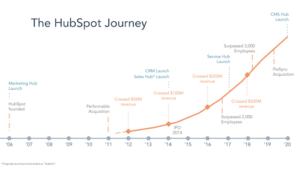Ever feel like you’re always chasing the next big marketing trend, and then hoping it’ll be the answer to your business’ explosive growth? We’ve all been that person.
But what if there was a way to use more than just fleeting tactics and build a sustainable growth engine for your business?
Enter the world of growth marketing.
What is Growth Marketing?
Conventional or what we know as traditional marketing primarily involves creating awareness through campaigns and advertisements. It focuses on the brand itself. Whereas growth marketing concentrates on achieving fast, consistent growth through every step of the customer process. In other words, its focus is on the entire customer journey. The full marketing funnel.
But what specifically sets them apart? Growth marketers use analytics and customer data to experiment and optimize marketing strategies for improved results.
As Mark Fiske, a Senior Executive Director at Digital Strategies, explains:
“Growth marketing is the set of practices, rituals, and processes rooted in experimentation and understanding of the customer that ultimately results in sustainable, repeatable, growth for an organization.”
Why is Growth Marketing So Hot Right Now?

In today’s cutthroat digital environment, we should not depend only on attractive branding and memorable slogans. To distinguish ourselves, we need smart tactics supported by data that can break through the clutter and get through to our desired audience – our target market.
This is where growth marketing excels. By combining creativity with analytical skills, it allows growth marketers to identify the most effective channels and messages so we can achieve maximum ROI.
Let’s take a look at some key benefits of an effective growth marketing strategy:
- Rapid acquisition of new customers
- Higher customer lifetime value and retention
- Lower customer acquisition costs over time
- Ability to scale and grow rapidly yet sustainably
Now that we’ve got the what and why sorted out, let’s get into how to actually develop a killer growth marketing strategy.
Building Your Growth Marketing Strategy Step-by-Step
So where do we start with our growth marketing strategy?
Regardless of what industry you’re in or what type of company you run, these foundational marketing strategies are a must.
1. Define Your Goals and Key Metrics
Just as with any effective marketing strategy, it is important to establish first, clearly defined, trackable objectives that are in line with your overarching business goals. Think measurable targets like:
- Increase monthly recurring revenue by 25% this year
- Acquire 500 new customers per month
- Boost email list by 10k subscribers per quarter
- Achieve 40% annual revenue growth rate
Then outline the key metrics you need to monitor, such as conversion rates, customer acquisition costs, and churn rates. Using tools like Google Analytics and CRM platforms can be very helpful for measuring data.

2. Research Your Target Audience
Who exactly are your ideal customers? What channels and type of content really clicks with them? Time to dive into audience research!
Use surveys, social listening, analytics, you name it. The more detail you can gather on their demographics, interests, pain points, buying journeys – the better. Getting hyper-specific on your target personas will power the rest of your strategy.
Don’t know how to start with personas? Download our free template here to get started.
3. Map the Customer Journey
Next, chart out each touchpoint in the customer journey from recognition to support. Having a full-funnel mindset is what you need to succeed in growth marketing.
Here are a few stages and the corresponding content as examples:
- Awareness: Blog content, social media, SEO
- Consideration: Webinars, email nurturing
- Conversion: Free trials, sales demos
- Retention: Loyalty programs, upsells
- Advocacy: Reviews, referral schemes
Nailing your audience’s end-to-end journey is key to developing resonant, growth-oriented strategies.
4. Brainstorm Potential Channels and Experiments

Time to get creative! Based on your goals and audience research, brainstorm all the potential marketing channels and campaigns you could experiment with.
Some high-impact options loved by growth teams:
- Content marketing (blogs, videos, podcasts)
- SEO and SEM
- Email marketing
- Social media
- Partner/Affiliate marketing
- Referral programs
- Free tools or trials
- Sales outreach
- Mobile app promotions
Look at what’s working for competitors or growth leaders in your industry as inspiration. Tools like SimilarWeb can give you a peek into their top acquisition channels.
5. Prioritize and Design Experiments
You can’t test everything at once, so prioritize 2-3 high-impact experiments to start based on your goals, resources and audience data. Design each test methodically:
- Hypothesis: What are you testing and why?
- Success metrics: How will you measure results?
- Timeframe: How long will you run the test?
- Control group: What’s your benchmark?
Document every aspect to ensure data integrity. Use platforms like Unbounce and Optimizely to simplify experiment design and deployment.
6. Execute and Analyze Results

Launch your first round of experiments and monitor the performance data closely. Once you have a good amount of data, it’s a good time to analyze the results and think about creating iterations.
Become a data guru. What worked awesomely? What flopped? How can you amplify the wins or pivot from the losses? Don’t be afraid to dig into both quantitative metrics and qualitative feedback.
Growth marketing is a continuous process of running new experiments based on learnings. Rinse and repeat!
7. Scale What Works
As certain channels and tactics prove successful, invest more resources into scaling them up. Automate and systematize processes as much as possible.
This compounding growth is the bread and butter of a good growth marketing strategy. JJust look at how Hubspot strategically used content marketing for massive growth:

Image from SaaStr
Iconic Examples of Brilliant Growth Marketing
To wrap up, let’s look at some iconic examples of brilliant growth marketing strategies that propelled businesses to new heights:
Dropbox
The file-sharing company is a master class in incentivized referral marketing and viral growth loops. By offering free storage for referrals, they added millions of new users. Simple but genius!

“Our constraints cultivated some of our biggest growth techniques like the referral program.” – Drew Houston, Dropbox CEO
Dollar Shave Club
With a hilarious viral video, DSC showed the power of creating buzz-worthy content. Their $4,500 video generated over 12,000 sign-ups in 2 days and millions in revenue!
“For us, everything was tied into the viral video.” – Michael Dubin, CEO
Spotify
The music streaming service lets users share songs across social platforms for free, displaying paid subscription ads. This a brilliant “freemium” model that constantly generates new users primed for conversion, boasting a 46% conversion rate to paid services. In comparison, Slack has a conversion rate of just 30%, while Evernote sits at 4%, and Google Drive at 0.5%.

As you might have garnered from the example above, these brands were able to rapidly scale and dominate their markets by staying laser-focused on sustainable growth, constantly experimenting, and optimizing their strategies.
Growth Marketing vs. Traditional Marketing: How Do They Compare?
Below is a table that lays out the contrasts side by side, like two pictures from different eras. One showcases the classic, broad-brush approach, while the other zooms in on the fine details, adapting with every brushstroke.
So, take a moment to peruse this comparative snapshot—it might just be the map you need to navigate the marketing landscape ahead.
| Growth Marketing | Traditional Marketing |
| Data-driven, focused on rapid growth | More focused on brand awareness & acquisition |
| Targets full customer lifecycle | Linear, campaign-based approach |
| Utilizes experimentation and constant iteration |
Relies more on “gut feel” than hard data |
| Emphasis on digital channels and loops | Heavier use of outbound, offline channels |
| Metrics like CAC, LTV, viral coefficients | Metrics like impressions, conversions, sales |
Of course, the two marketing styles can be complementary when used in tandem skillfully. But if rapid, sustainable growth is your goal, incorporating growth marketing strategies is a must.
Start Developing Your Growth Machine Today
In today’s uber-competitive landscape, growth marketing isn’t a nice-to-have, it’s a necessity. When you combine the right data, creativity, and experimentation, you can create a powerful growth strategy to scale your business like never before.
So what are you waiting for? Follow the steps above, study those inspiring examples, and start developing your own growth marketing strategy.
Need help? Let’s talk.
